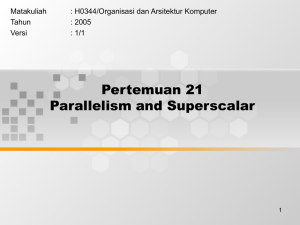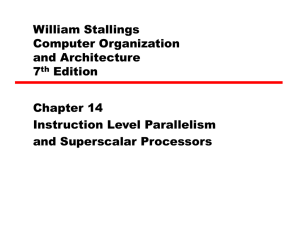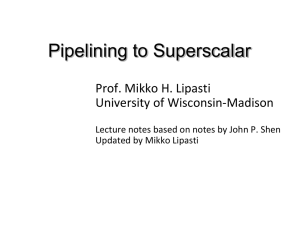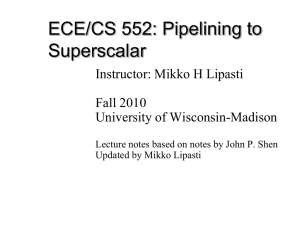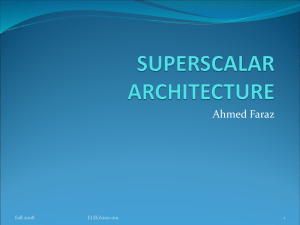CH16-COA9e
advertisement
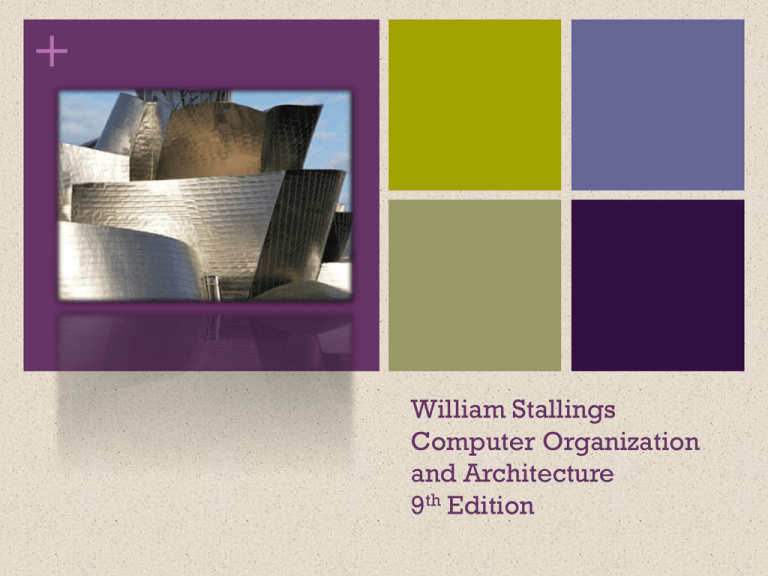
+ William Stallings Computer Organization and Architecture 9th Edition + Chapter 16 Instruction-Level Parallelism and Superscalar Processors Superscalar Overvi ew Term first coined in 1987 Refers to a machine that is designed to improve the performance of the execution of scalar instructions In most applications the bulk of the operations are on scalar quantities Represents the next step in the evolution of high-performance general-purpose processors Essence of the approach is the ability to execute instructions independently and concurrently in different pipelines Concept can be further exploited by allowing instructions to be executed in an order different from the program order Superscalar Organization Compared to Ordinary Scalar Organization Table 16.1 Reported Speedups of Superscalar-Like Machines + Comparison of Superscalar and Superpipeline Approaches + Constraints Instruction level parallelism Refers to the degree to which the instructions of a program can be executed in parallel A combination of compiler based optimization and hardware techniques can be used to maximize instruction level parallelism Limitations: True data dependency Procedural dependency Resource conflicts Output dependency Antidependency + Effect of Dependencies + Design Issues Instruction-Level Parallelism and Machine Parallelism Instruction level parallelism Instructions in a sequence are independent Execution can be overlapped Governed by data and procedural dependency Machine Parallelism Ability to take advantage of instruction level parallelism Governed by number of parallel pipelines + Instruction Issue Policy Instruction issue Instruction issue policy Refers to the protocol used to issue instructions Instruction issue occurs when instruction moves from the decode stage of the pipeline to the first execute stage of the pipeline Three types of orderings are important: Refers to the process of initiating instruction execution in the processor’s functional units The order in which instructions are fetched The order in which instructions are executed The order in which instructions update the contents of register and memory locations Superscalar instruction issue policies can be grouped into the following categories: In-order issue with in-order completion In-order issue with out-of-order completion Out-of-order issue with out-of-order completion + Superscalar Instruction Issue and Completion Policies Organization for Out-of-Order Issue with Out-of-Order Completion Register Renaming Output and antidependencies occur because register contents may not reflect the correct ordering from the program May result in a pipeline stall Registers allocated dynamically Speedups of Various Machine Organizations Without Procedural Dependencies + Branch Prediction Any high-performance pipelined machine must address the issue of dealing with branches Intel 80486 addressed the problem by fetching both the next sequential instruction after a branch and speculatively fetching the branch target instruction RISC machines: Delayed branch strategy was explored Processor always executes the single instruction that immediately follows the branch Keeps the pipeline full while the processor fetches a new instruction stream Superscalar machines: Delayed branch strategy has less appeal Have returned to pre-RISC techniques of branch prediction Conceptual Depiction of Superscalar Processing + Superscalar Implementation Key elements: Instruction fetch strategies that simultaneously fetch multiple instruction Logic for determining true dependencies involving register values, and mechanisms for communicating these values to where they are needed during execution Mechanisms for initiating, or issuing, multiple instructions in parallel Resources for parallel execution of multiple instructions, including multiple pipelined functional units and memory hierarchies capable of simultaneously servicing multiple memory references Mechanisms for committing the process state in correct order Pentium 4 Block Diagram Pentium 4 Pipeline + Pentium 4 Pipeline Operation Page 1 of 2 + Pentium 4 Pipeline Operation Page 2 of 2 ARM CORTEX-A8 ARM Cortex-A8 Integer Pipeline + Instruction Fetch Unit Predicts instruction stream Fetches instructions from the L1 instruction cache Places the fetched instructions into a buffer for consumption by the decode pipeline Also includes the L1 instruction cache Speculative (there is no guarantee that they are executed) Branch or exceptional instruction in the code stream can cause a pipeline flush Can fetch up to four instructions per cycle F0 Address generation unit (AGU) generates a new virtual address Not counted as part of the 13-stage pipeline F1 The calculated address is used to fetch instructions from the L1 instruction cache In parallel, the fetch address is used to access branch prediction arrays F3 Instruction data are placed in the instruction queue If an instruction results in branch prediction, new target address is sent to the address generation unit + Instruction Decode Unit Decodes and sequences all ARM and Thumb instructions Dual pipeline structure, pipe0 and pipe1 Two instructions can progress at a time Pipe0 contains the older instruction in program order If instruction in pipe0 cannot issue, instruction in pipe1 will not issue All issued instructions progress in order Results written back to register file at end of execution pipeline Prevents WAR hazards Keeps track of WAW hazards and recovery from flush conditions straightforward Main concern of decode pipeline is prevention of RAW hazards + Instruction Processing Stages D0 D1 Writes instructions into and read instructions from pending/replay queue D3 Instruction decode is completed D2 Thumb instructions decompressed and preliminary decode is performed Contains the instruction scheduling logic Scoreboard predicts register availability using static scheduling Hazard checking is done D4 Final decode for control signals for integer execute load/store units Table 16.2 Cortex-A8 Memory System Effects on Instruction Timings Table 16.3 Cortex-A8 Dual-Issue Restrictions + Integer Execute Unit Consists of: Two symmetric arithmetic logic unit (ALU) pipelines For ALU instructions, either pipeline can be used, consisting of the following stages: An address generator for load and store instructions The multiply pipeline The instruction execute unit: Executes all integer ALU and multiply operations, including flag generation Generates the virtual addresses for loads and stores and the base writeback value, when required Supplies formatted data for stores and forwards data and flags Processes branches and other changes of instruction stream and evaluates instruction condition codes E0 Access register file Up to six registers for two instructions E1 E2 If needed, completes saturation arithmetic E4 ALU function E3 Barrel shifter if needed. Change in control flow prioritized and processed E5 Results written back to register file Load/Store Pipeline Runs parallel to integer pipeline E1 E2 + Address applied to cache arrays E3 Load -- data are returned and formatted Store -- data are formatted and ready to be written to cache E4 Memory address generated from base and index register Updates L2 cache, if required E5 Results are written back into the register file Table 16.4 Cortex-A8 Example Dual Issue Instruction Sequence for Integer Pipeline ARM Cortex-A8 NEON & Floating-Point Pipeline Summary + Chapter 16 Superscalar versus Superpipelined Instruction-Level Parallelism and Superscalar Processors Design issues Instruction-level parallelism Machine parallelism Instruction issue policy Register renaming Branch prediction Superscalar execution Superscalar implementation Pentium 4 Front end Out-of-order execution logic Integer and floating-point execution units ARM Cortex-A8 Instruction fetch unit Instruction decode unit Integer execute unit SIMD and floating-point pipeline
